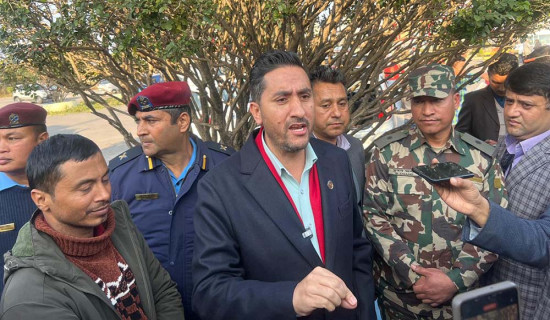- Saturday, 3 January 2026
Self-reliance In Food
As the world is passing through the Fourth Industrial Revolution, Nepal’s agriculture, manufacturing and other areas of economy are still lagging behind in embracing cutting-edge technologies for fast, efficient, cost-effective and mass production of food. This is why our products lack competitive advantage compared to those of the neighbouring and other countries. The Fourth Industrial Revolution is marked by removal of the boundaries between physical, digital and biological realms. It blends the essential eight technologies such as artificial intelligence (AI), robotics, the Internet of Things (IoT), genetic engineering and quantum computing, which have brought drastic changes to the social, economic, academic and cultural activities.
Agriculture is such a sector that reflects huge impacts brought by every Industrial Revolution. The developed countries have applied advanced technologies in the agriculture sector to enhance production and productivity. The latest revolution helps build a smart farming with digital technology, bringing significant changes to the production and agro-processing. It boosts production, and reduces costs and adverse environmental repercussions. But the poor countries like Nepal still rely on traditional methods of farming. As a result, we are unable to produce agro products in terms of quantity and quality. Not only this, Nepal has become dependent on the imported goods, ranging from food to textiles and cosmetics to medicines. Despite being an agricultural nation, Nepal finds it difficult to produce enough food for its population. Billions of rupees are spent on importing rice, maize and wheat from other nations. Climate change has added another challenge to the agro sector that is now facing a lack of workforce, investment and incentives.
The other day, the country celebrated the 21st National Paddy Day with the slogan of 'the climate resilient farming, increase in paddy production.' The farmers marked the occasion by planting new rice saplings and relishing Dahi Chiura. The President, Prime Minister, ministers and the people from different walks of life planted paddy to observe the Day that is inherently connected to the social, economic and cultural life of Nepalis. Also known as Asar Pandhra, it is well elucidated by a popular saying ‘mano ropera muri ubjaune’ (sowing in grams to grow in tonnes). Once this phrase matched the agro sector as the country used to produce surplus food and export the food items to different countries. With the neo-liberalisation policy adopted since the early 1990s, subsidies and incentives to the agro sector were removed, causing a decline in agro products.
The country imported paddy and rice worth Rs. 33.63 billion during the first 11 months of the current fiscal year. However, increase in the production of paddy and change in the people's rice–eating habits has led to the fall in the imports of the food. Participating in the National Paddy Day in Chitwan, Prime Minister Pushpa Kamal Dahal Prachanda said that the government had prioritised research and development of climate-friendly technologies to minimise the negative impacts of climate change and increase the production of rice. It is imperative to use high-yielding rice varieties with high nutritional value, and the use of farmer-friendly technologies. To attract the youths to agriculture, the sector needs to be commercialised and diversified. The concerned agencies should be proactively involved in ensuring timely availability of the chemical fertilisers, quality seeds, technology expansion, research and minimum support price. Only then can the nation achieve self-reliance on food.

















